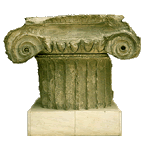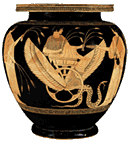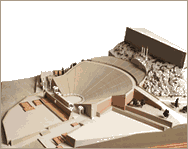 Ionic capital from the Temple of Athena in Priene, 4th century BCE
Ionic capital from the Temple of Athena in Priene, 4th century BCE
|
In a historical context, the term "classical" refers to the specific period in Greek civilization between the Archaic and the Hellenistic periods, a brief but luminous window in world history that opened with the Greek defeat of the Persians at the beginning of the fifth century BCE and closed with the death of Alexander the Great at the end of the fourth century. But we also use the term "classical" -- or "classic" -- in a broader sense to describe things that seem precisely to transcend any specific historical context. Here the term suggests a kind of timeless quality: a value that outlasts the fads and fancies of passing ages, a standard of excellence that offers an enduring point of reference by which to measure other things. (Thus we speak of classical music, classic works of literature, and, nowadays, even classic cars and classic beauties.) The artistic and intellectual achievements of Classical Greece in the historical sense-- that astonishingly creative period in which the Acropolis, the sculptures of Phidias, the tragedies of Aeschylus, Euripides, and Sophocles, and the works of Plato and Aristotle were all produced-- are paradigmatically classical in this broader sense too. No list of the "classics" of art, literature, architecture, or philosophy is complete without the works of the Classical Greeks. And perhaps no other cultural epoch has exercised such a tremendous influence over later periods in history.
But how much do we really know about the historical Greeks of the Classical era? What was ordinary life like in this extraordinary period of cultural flourishing, in particular for women or slaves, or even just average workers-- those most likely to slip through the cracks of the historical record? In what context were those masterpieces of Classical culture, so often regarded outside of any context, really created? Indeed, to what extent has the assimilation of Classical culture into a collective heritage-- the elevation of its artifacts to the level of timeless "classics" -- made it more difficult for us to understand the Classical era as a concrete historical period with its own time-bound complexities and contradictions? These are some of the questions explored by an ambitious new exhibition-- entitled "The Greek Classical Period: Idea or Reality" (Die Griechische Klassik: Idee oder Wirklichkeit)-- on display at the Martin Gropius Gallery in Berlin, Germany until June 2, 2002. With over 600 pieces on loan from nearly 120 museums around the world, this comprehensive exhibition aims to present a multi-faceted view of the Classical age of Greece, one that brings to life the full character of this intriguing period in which sublime achievement occurred side by side with war and violence, and democratic institutions flourished in the midst of inequality and discrimination. Organized around eight different themes, the exhibition seeks to provide a deeper understanding of key concepts of Classical antiquity by anchoring them in a historical context carefully reconstructed from the latest archaeological findings. Fifth century Athens, undoubtedly the jewel in the Classical crown and also the source of most of our material evidence, forms the focal point of the exhibition.
 Attic red-figured stamnos from around 480 BCE
Attic red-figured stamnos from around 480 BCE
|
The first section, "Athens and the World in the Fifth Century BCE," offers a broader view of the world in which Athens rose to pre-eminence. Selected objects from other cultures contemporary to the fifth century Greeks illustrate not only the regions with which they had contact (Scythia, Persia, Egypt, Iberia) but also those well beyond the bounds of their knowledge (Nigeria, China, Japan, Guatemala). Athenian coins discovered in Egypt-- distinctively marked with owl and olive branch-- and amphorae from ancient shipwrecks off the Mediterranean trace out the main trade routes of the Athenians, for whom shipping was a major economic resource. The structure of the society built on this wealth from trade and shipping is explored in the second section of the exhibition, which focuses on the theme of "Politics and the Public Domain." Aside from pieces of ostraka, the pot shards used to vote citizens into exile, there is not much material evidence of the day-to-day functioning of the political bureaucracy. But the complexity of Athenian public life is illustrated by grave stelai, which reflect its social hierarchies, and devotional images and votive reliefs, which demonstrate the social relevance of religion: the one area of the public domain in which social hierarchy played no role. Most interestingly, it is here in fifth century Athens that we see the first portraits in European history, in the form of bronze or marble busts and full-length statues honoring individuals who had distinguished themselves from society as a whole. These realistic portraits, so different from the highly formulaic representations found in the Archaic period, offer a vivid indication of the way in which the unprecedented democratic institutions of Athens allowed for an emerging emphasis on the individual. Included in this section of the collection are Roman copies of fifth century busts of Socrates, Plato, Aristotle, Miltiades, Themistocles, Pindar, and Pericles.
The pioneering portraits of the fifth century are just one example of the way in which Classical art as a whole was definitively centered on the human form. But what were the symbols and motifs used to depict the men, women, and children who figure so prominently in the art of the Classical period? The third section of the exhibit-- "Life in Images, Living with Images" -- explores the conventions and styles used in sculpture and vase paintings. By far the most striking piece here is a life-size portrait of the lyric poet Anacreon, a second century AD Roman copy of a bronze original dated from around 450 BCE. Shown reciting at a symposium, the bearded poet stands with one arm raised-- gesturing, perhaps, to the rhythm of his words-- while the cloak draped around his shoulders falls away in deep folds from an otherwise naked body. The tilt of his head and the sway of his hips suggest that Anacreon has been captured in a moment of tipsy euphoria, but the sculptor was careful to add a stylistic detail meant to remind us of the esteemed poet's self-control. Anacreon's genitals appear to be tied in a knot: a symbol, often used to show respect, which represents moderation and restraint.
 Statue of an Ephebe, height 102 cm. From around 480 BCE
Statue of an Ephebe, height 102 cm. From around 480 BCE
|
The ideals of restraint and moderation, so central to Classical society, were not merely celebrated in the art of the period but also expressed by the artistic representations themselves. Proportion, balance, precision, and measurement were the governing ideals of the art and architecture of Classical antiquity, and these all-important concepts constitute the fourth theme of the exhibition. Construction plans of the Parthenon-- that enduring symbol of architectural grace-- and a model of the staggeringly massive Mausoleum at Halicarnassus give us the opportunity to explore the proportions of Classical architecture on a grand scale, while reconstructions of the private houses and furniture of middle class Greeks living in Asia Minor give us a glimpse into the more mundane, but no less fascinating, sphere of ordinary living. In the domain of sculpture, where the concepts of proportion and balance find, perhaps, their most perfect expression, we are shown the way in which artists like Polycleitus of Argos brought the science of measurement and precision to the art of depicting the human body. The first sculptor to write a theoretical treatise about his art, called "The Canon," Polycleitus used mathematics to define the proper proportions of a harmonious and ideally balanced composition. Displayed here is Polycleitus' famous Doryphoros, or Spear-Bearer, an exquisite example from 450 BCE of the contra posto pose which was to become an archetype for representations of the male nude in later artistic periods-- as illustrated by the Roman copies exhibited alongside the original.
But how did sculptors like Polycleitus produce their masterpieces? What materials did they use, and where did they get them? How were those dazzling monuments of the Classical period financed, and how was the production process coordinated? History records the finished products of human activity, the tangible objects that can survive the passage of time, if not in original material form, then at least as immortalized in reproductions or in the admiring descriptions of legend. But what about the ordinary human labor behind the finished products-- the hard, sweaty, dirty, unglamorous work that goes on behind the scenes, invisible to history? The fifth section of the exhibition-- organized around the theme "The Basis of Classical Culture: Land and Work" -- explores the evidence of this human activity that so easily disappears with the passing of time. Samples of grains and ores from the indigenous habitat, ancient tools, and finds from silver mines illustrate the main sources of industry that underpinned the economy of Classical Greece and financed its ambitious architectural projects: agriculture, mining, shipping, and specialized artisan trades, for example. The working conditions and living routines of ordinary laborers and slaves, so hard to document archaeologically, are brought to life with the help of a detailed model of an ancient ore washing plant, while a model of the workshop of Phidias, the artist of the Parthenon marbles and probably the most important sculptor of Athens, gives us insight into the real, material context in which the great works of the Classical period were created. Particularly interesting additions to the collection are some examples of unfinished works of art and preparatory drawings for vase paintings, which offer an intriguing look into the artistic process.
 Bust of Pericles from Lesbos, height 54 cm. 1st century AD Roman copy of a bronze original dated around 430 BCE
Bust of Pericles from Lesbos, height 54 cm. 1st century AD Roman copy of a bronze original dated around 430 BCE
|
While the first five sections of the exhibition aim to give a deeper understanding of-- and thus to bring to reality-- aspects of the Classical tradition often known to us more through our own idealizations and romanticized conceptions than through a well-grounded familiarity with the material past, sections six through eight are more concerned with exploring the idea of the Classical. What is distinctly Classical? What has the Classical ideal meant to, and how has it influenced, later periods? For Phidias in his workshop, the art he was creating was not self-consciously part of some movement or style or artistic period. The development of a distinct conception of the Classical came once a more deliberate stance was adopted toward Classical culture. The sixth section of the exhibition considers some ways in which Classical archetypes became canonized and a formalized conception of Classicism developed in the fourth century BCE, as Greek influence, culture, and language spread under the consolidating power of Macedonia, and Classical styles began to be consciously emulated throughout the Mediterranean and Black Sea area. A model of the Theater of Dionysus, portraits of the ancient tragedians, including a larger-than-life Sophocles on loan from the Vatican Museum, and papyrus fragments from the tragedies of Euripides, Aeschylus, and Sophocles-- written down for the first time in the fourth century-- illustrate the way in which theater played a central role in shaping a public conception of the Classical, as Greeks themselves began to regard their own cultural works as a set of "classics."
The last two sections (sections seven and eight) take as their theme the revival of Classical ideas in later periods, from ancient Rome to today. Artists throughout the centuries-- from Ovid to Michelangelo, from Racine to Goethe, from Karl Friedrich Schinkel, Berlin's most famous architect, to American dancer Isadora Duncan-- have found in the Classical tradition a point of reference for their own work. Indeed, entire periods of cultural history, such as the Italian Renaissance and the Neoclassical movement in 18th century Germany, can be seen as attempts to revive the culture of Classical Greece. What did these later "Classicisms" adopt from Greek Classical antiquity? Section eight of the exhibition concentrates on modern times, tracing out, primarily through book displays, the reception of Classical concepts from the Renaissance to the 20th century. There is some interesting material here; most notably, and soberingly, there is a video of a 1936 film by Leni Riefenstahl, Hitler's propagandist, which makes free use of the symbols of Classical Greece so unabashedly misappropriated by the Nazis. But from an archaeological point of view, the most interesting material is in the seventh section, which focuses on the revival of Classicism in the Roman empire, depicting through fine examples of the sculpture, silverwork, and pottery of the period the extent to which Rome under the emperors Augustus and Hadrian tried to recreate the forms and styles of Greek Classical antiquity.
 Model of the theatre of Dionysus in Athens, as it stood in the 4th century BCE. Model on a scale of 1:200, built by Petros Dimitriadis, Athens
Model of the theatre of Dionysus in Athens, as it stood in the 4th century BCE. Model on a scale of 1:200, built by Petros Dimitriadis, Athens
|
The Romans entirely assimilated the culture of Greece, adopting its religious and mythological motifs, for example, and assiduously copying statue after statue-- sometimes simply adding on custom-made portrait heads to depict the elite of their own day. And in a very real sense, our own ideas about the Classical period have been shaped by Rome's conscious mirroring of Greek culture. Indeed, that we use a Latin-derived term to describe the heyday of Greek civilization (as we use Latin words to describe so many originally Greek concepts) is indicative of the degree to which our ideas of the Classical have been transmitted to us through the cultural ascendancy of a Hellenized Rome. The archaeological record itself provides a very concrete example of the extent to which this is true: much of the canon of Greek art survives only in replica, through the copies made by Roman artists. At the same time as this greatly increases our access to the culture of the Classical period, it also raises an interpretive problem for archaeologists faced with the task of assessing the material evidence. What is original, what is Roman copy? This is vividly illustrated by the debate surrounding one of the pieces included in the collection, "Aphrodite with Tortoise," now thought by some to be an original Phidias from around 420 BCE rather than a Roman copy. More generally, it also raises interesting questions about our access to the past. What was lost in the original, but never copied? We can only guess at how well the full range of Classical art and culture is represented by what still survives; we can only imagine how great the gap might be between idea and reality.
Elisabeth Herschbach is a doctoral candidate in Philosophy at the University of Pennsylvania. |






